Ventilation units (VUs) use electricity to expel stale air from a room, replacing it with fresh air from the outside.
In the heating season, the incoming outside air is colder than the outgoing indoor air. An efficient ventilation unit therefore preferably includes a heat recovery system that uses the heat contained in the outgoing air to warm up the incoming air. In this way heat losses due to ventilation are reduced (as compared to natural ventilation, e.g. opening windows) and energy can be saved on the space heating system.
Consequently energy efficiency of VUs has two aspects: (1) the reduction of electricity consumed by the VU itself, and (2) the reduction of the space heating load and associated reduction of energy consumed by space heating products. If the space heating efficiency is low, the load-reduction due to VUs becomes relatively more important.
Ecodesign regulation 1253/2014 on VUs acknowledges that there may be an interaction between the two efficiency aspects: non-residential VUs having a higher heat exchange efficiency are therefore allowed to consume more power for the fans they employ.
Unidirectional ventilation systems provide an air flow in one direction. This means that the ventilation unit either supplies or exhausts air only. The ventilation equilibrium is balanced by natural air exhaust or supply.
Balanced ventilation systems supply fresh air with the same rate as they expel stale air. This maintains a balanced pressure system in the building. If the ventilation systems is ducted, it should be separated from other ducted systems such as air conditioning, to prevent the disturbance of the pressure balance.
Source: estimations from the Ecodesign Impact Accounting Overview Report 2024
Scope
The following table shows some examples of products in scope and out of scope in the Ecodesign Regulation:
| In Scope | Out of Scope |
|---|---|
|
|
Check the complete list in the Ecodesign Regulation and Energy Labelling Regulation.
Ecodesign Requirements
Ecodesign requirements covering energy efficiency and product information apply to ventilation units sold in the EU for use in residential and non-residential buildings.
Energy Label
Residential ventilation units must display a label indicating their energy efficiency on a scale from A+ (most efficient) to G (least efficient). These ratings take into account:
- specific power input (SPI)
- thermal efficiency of heat recovery
- type of ventilation control
- other factors
The European Product Registry for Energy Labelling (EPREL) offers more detailed information on models placed on the EU market. This can be accessed by scanning the QR code featured on the new energy labels.
| Understanding the Ventilation Unit Energy Label | |
|---|---|
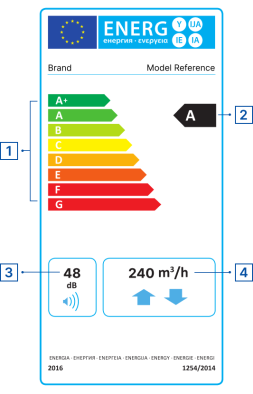 |
|
Highlights
Ventilation systems in buildings replace 'used' air with fresh air from outside. This is often done using ventilation units: these consist of fans, motors, electronic controls and other devices (such as heat recovery systems) and are connected to buildings by air inlets and outlets or ventilation ducts.
Ventilation units consume more than 2% of all electricity in the EU, and are amongst the biggest consumers of indoor electricity, after heating and cooling, and lighting.
By using more efficient ventilation units, EU citizens are estimated to save 1300 PJ energy use in 2025 and each year after that.
Facts & Figures
This graphic shows the estimated sales, stock, energy consumption (primary, electric or fuel), greenhouse gas emissions, consumer expenses and business revenues for years 2010 and 2030. The estimated values inside the graph bars are those from the EIA ECO-scenario, they include the effects of Ecodesign and Energy Labelling measures.
The difference with the business as usual (BAU) scenario without these estimated measures is shown next to the graph bar. These figures indicate the estimated savings obtained due to the measures.
Product: Ventilation Units Measures: Regulation (EU) 1253/2014, Regulation (EU) 1254/2014 |
|---|
| The striped lines in the charts show the 'Effect of the Regulations' |
SALES (x1000 units) 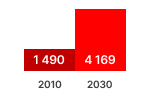 | STOCK (x1000 units) 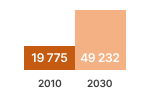 | Electricity (TWh/a) 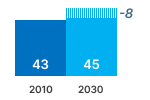 |
GHG-EMISSION 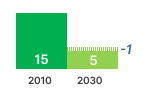 | CONSUMER EXPENSES 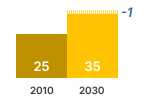 | REVENUES  |
Source: estimations from the Ecodesign Impact Accounting Overview Report 2024
In 2020, 28 million continuously operating ventilation units (VUs) were in use in EU27 (not including intermittently operating exhaust fans in e.g. toilets or bathrooms).
20 million VUs (71%) were for residential use, servicing 25% of the EU27 residential dwelling area with 33 trillion m3 of fresh air per year, corresponding to 1890 m3 per dwelling per day.
8 million VUs (29%) were for non-residential use, estimated to service 72% of the EU27 non-residential building area with 100 trillion m3 of fresh air per year, corresponding to 25500 m3 per building per day.
56% of the air is ventilated during the heating season, allowing VUs to recover 100 TWh of heat in 2020. This is 4% of the total EU27 heat demand (2360 TWh) and decreases the heat to be produced by space heaters.
To do this work, VUs consumed 43 TWh of electricity in 2020: 1.8% of the total EU electricity consumption, and close to the consumption of Romania (44 TWh).
Without measures, residential VUs would have consumed 8.4 TWh of electricity in 2020, with an air flow efficiency of 0.263 Wh/m3. Due to Ecodesign measures, this has been reduced to 7.7 TWh with an efficiency of 0.233 Wh/m3: an improvement of 11%.
For non-residential VUs the improvement in 2020 is from 36.7 TWh (0.370 Wh/m3) to 35.0 TWh (0.345 Wh/m3), an improvement of 7% .
The stock-average heat recovery efficiency in 2020 increased from 66.8% to 69.6% for residential VUs (+4.2% relative) and from 55.2% to 61.5% for non-residential VUs (+11.4%).
The regulations saved 2.5 TWh of electricity in 2020 (-5%), projected to increase to 8.4 TWh by 2030 (-16%).
The 2030 savings are 0.35% of the total EU27 electricity consumption (2384 TWh in 2020), and higher than the consumption of Estonia (7.2 TWh in 2020).
In addition, due to heat recovery by VUs, 17 TWh of final energy (fuel and electricity) were saved on space heating in 2020, expected to increase to 40 TWh in 2030.
Due to Ecodesign measures on VUs, EU27 users are projected to save € 0.9 billion in 2020 (-3%) and € 6.2 billion in 2030 (-17%).
Expected Savings
In 2015, the EU27 spent €18 bn on purchase and installation of ventilation units (of which €17 bn in the non-residential sector). Without Ecodesign measures this would increase to €21 bn in 2030 (+18%), mainly due to increased sales. Ecodesign measures will result in €0.7 bn extra acquisition costs for VUs in 2030 (due to higher prices for higher efficiency products).
The total EU27 energy costs related to VUs in 2030 are expected to drop by €7.1 bn due to the Ecodesign measures (€1.9 bn due to lower electricity costs for VUs and €5.2 bn due to lower energy costs for space heating).
Consequently, the net expenditure saving due to Ecodesign measures for VUs is €6.3 bn in 2030, increasing to a projected €10.0 bn in 2050.
Savings on Energy
Total EU27 Primary Energy Savings due to Measures on Ventilation Units
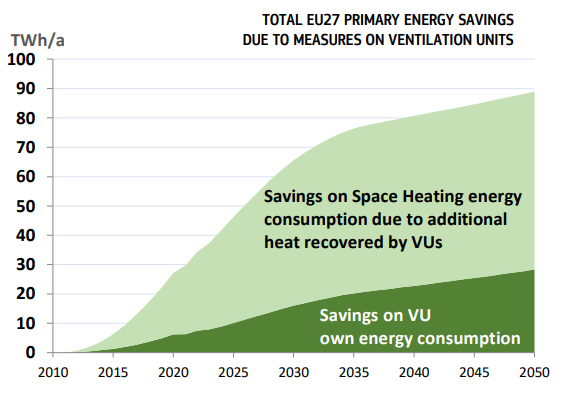
In 2015, VUs consumed 44 TWh/a of electricity for a total ventilated airflow of 113 Tm³/a, implying an average consumption of 0.39 Wh/ m³. In 2030, without measures, VUs would consume 53 TWh/a of electricity for a total ventilated airflow of 162 Tm³/a, with an average consumption of 0.33 Wh/m³. Due to the measures the electricity consumption is expected to be further reduced to 45 TWh/a or 0.28 Wh/m³ (28% less than in 2015, 15% less compared to the 2030 situation without measures). The electricity savings of 8 TWh in 2030 (corresponding to 16 TWh primary energy) are expected to further increase to 15 TWh in 2050 (28 TWh primary, with PEF 1.9).
In 2015, VUs recovered 70 TWh of heat from a total of 43 Tm³/a of air ventilated by balanced VUs in the heating season, with a stock average heat recovery efficiency of 43%. In 2030, without measures, VUs would recover 109 TWh of heat from 57 Tm³/a of ventilated air, with an efficiency of 51%. Due to the measures, the recovered heat in 2030 is projected to increase to 158 TWh (+45%) from 60 Tm³/a of ventilated air (+5%), with a higher heat recovery efficiency of 70%.
The recovered heat difference by VUs in 2030 in the scenario with measures compared to the scenario without measures is 158 – 109 = 49 TWh. This recovered heat difference due to VUs leads to an additional primary energy saving on space heating of 50 TWh/a (with a stock-average primary energy efficiency for space heating in 2030 of 90%, net calorific value, PEF 1.9). These savings are projected to increase to 61 TWh/a in 2050.
Consequently, the net positive effect in 2030 of Ecodesign measures on VUs is 68 TWh/a of primary energy. This is 4% of the total expected primary energy consumption for space heating in 2030.
The electric energy saving corresponds to a reduction in greenhouse gas emissions in 2030 of 0.9 MtCO2eq/a. An additional 7.3 MtCO2eq/a come from induced space heating savings.
Source: estimations from the Ecodesign Impact Accounting Overview Report 2024

Suppliers
Suppliers placing residential ventilation units on the market shall ensure that from 1 January 2016 the following requirements are fulfilled:
(a) each residential ventilation unit is accompanied by a printed label in the format and containing the information set out in Annex III, the label must be provided at least in the packaging of the unit. For each model of residential ventilation units an electronic label in the format and containing the information set out in Annex III shall be made available to dealers;
(b) a product fiche, as set out in Annex IV, is made available. The fiche must be provided at least in the packaging of the unit. For each model of residential ventilation units an electronic product fiche, as set out in Annex IV, shall be made available to dealers, and on free access websites;
(c) technical documentation, as set out in Annex V, is made available on request to the Member State authorities and the Commission;
(d) instructions for use are made available;
(e) any advertisement for a specific model of residential ventilation units that discloses energy-related or price information contains the specific energy consumption class of that model;
(f) any technical promotional material concerning a specific model of residential ventilation unit which describes its specific technical parameters states the specific energy consumption class of that model.
From 1 January 2016 residential ventilation units placed on the market shall be provided with a label in the format set out in Annex III, point 1, if they are unidirectional residential ventilation units, and with a label in the format set out in Annex III, point 2, if they are bidirectional ventilation units.

Dealers
Dealers shall ensure that:
(a) each residential ventilation unit, at the point of sale, bears the label provided by suppliers in accordance with Article 3(1)(a) on the outside of the front or top of the appliance in such a way as to be clearly visible;
(b) residential ventilation units offered for sale, hire or hire-purchase, where the end-user cannot be expected to see the product displayed, are marketed with the information provided by suppliers in accordance with Annex VI, except where the offer is made on the internet, in which case the provisions of Annex VII shall apply;
(c) any advertisement for a specific model of residential ventilation unit that discloses energy-related or price information contains a reference to the specific energy consumption class of the unit;
(d) any technical promotional material concerning a specific model which describes the technical parameters of a residential ventilation unit includes the specific energy consumption class of the model and the instructions for use provided by the supplier.

Policy
Ongoing legislative work
Please check the ongoing initiatives on the Have your say portal.
Regulation (EU) 1253/2014 of 7 July 2014 implementing Directive 2009/125/EC of the European Parliament and of the Council with regard to Ecodesign requirements for ventilation units Text with EEA relevance. More info on Delegated Act.
Regulation (EU) 1254/2014 of 11 July 2014 supplementing Directive 2010/30/EU of the European Parliament and of the Council with regard to Energy Labelling of residential ventilation units Text with EEA relevance.
Disclaimer: please pay attention to possible updates/changes as indicated in the Official Journal (green dot)

